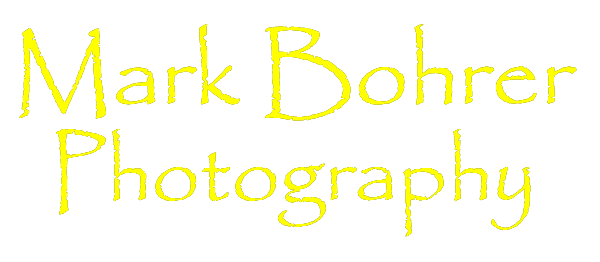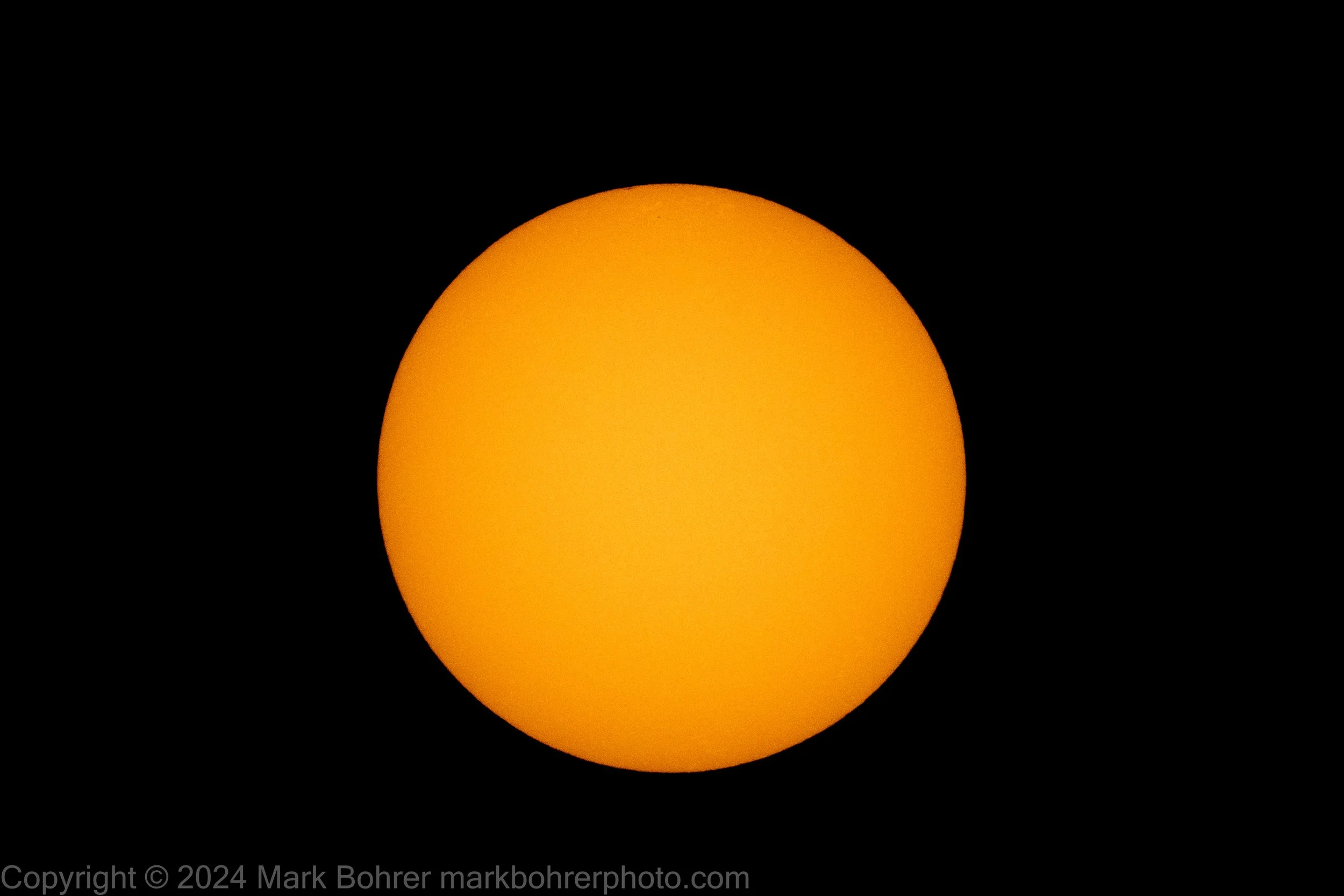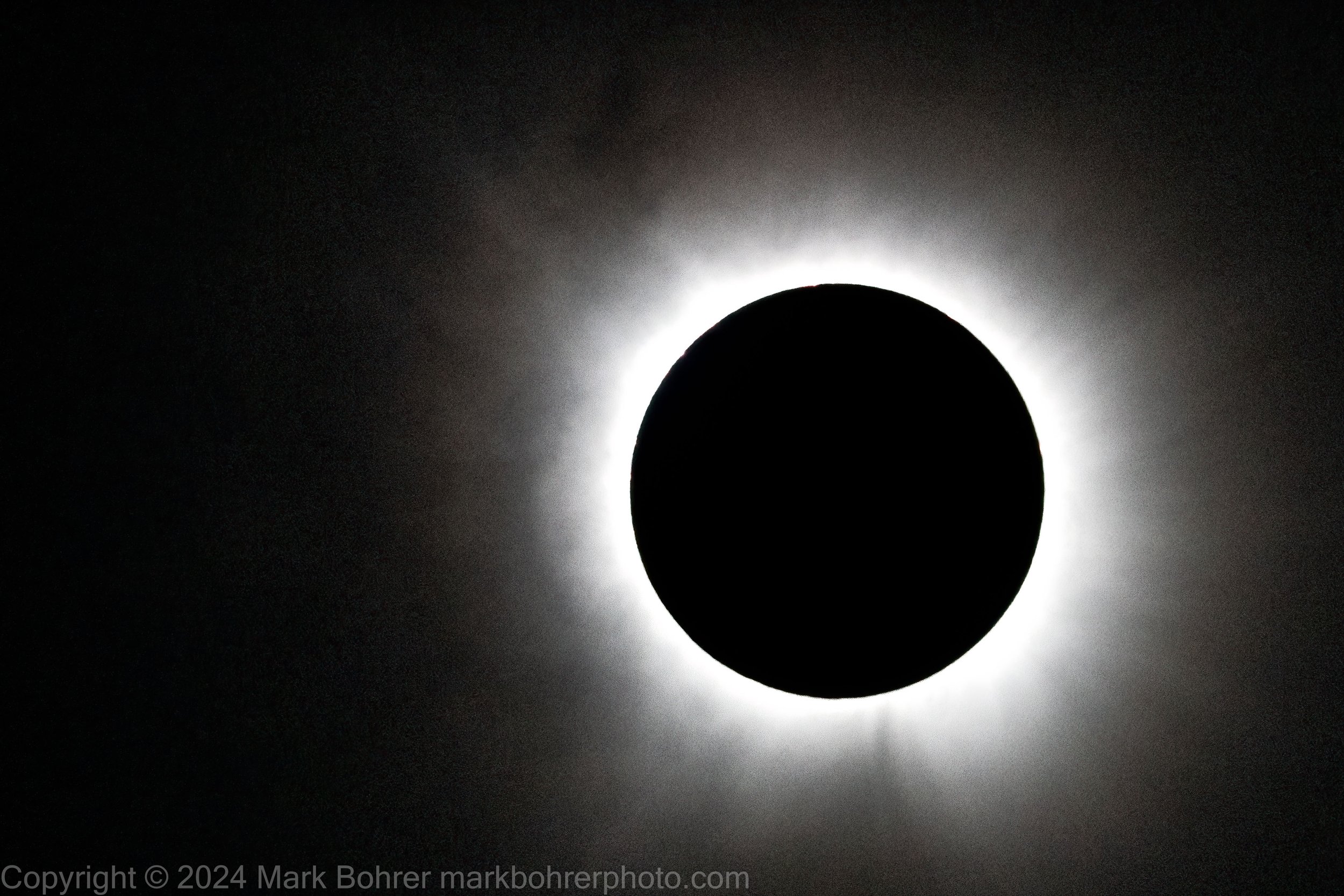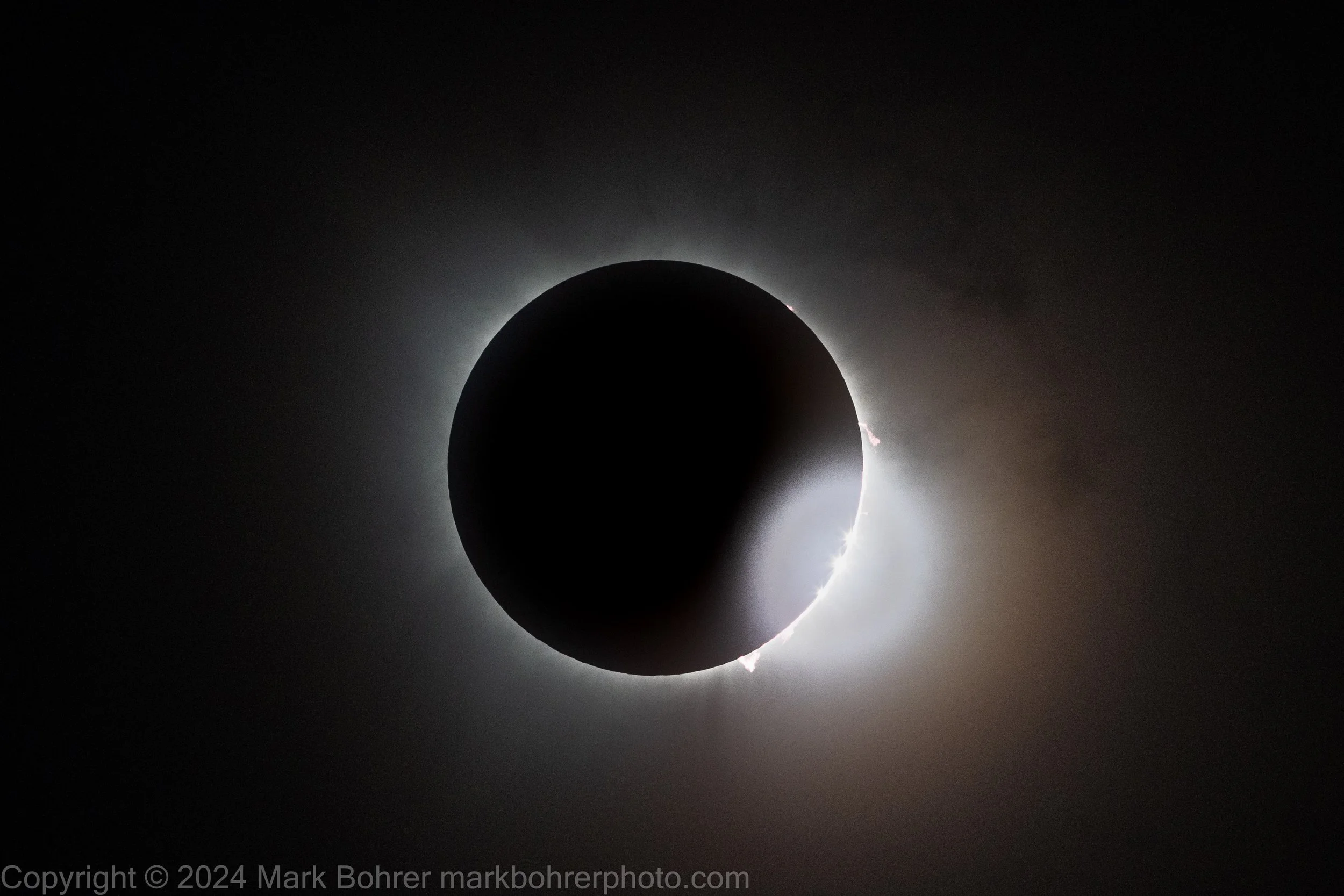Texas Totality
We'd planned 8 months in advance for the Great American Solar Eclipse of 2024. But as any military field commander can tell you, weather, logistics and just plain luck all play a part in what you finally get.
Full sun test shot, March
Hooked On Eclipses
Once you see a total solar eclipse, you're kinda hooked. We viewed the August 21, 2017 eclipse from Rexburg, Idaho. It was my first time actually seeing one - I got rained out on July 11, 1991 in Hawaii, playing hooky from a LAN standards meeting to attempt to see that one. But Rexburg was great - I had two long lens setups on tripods, one as a backup in case my main setup failed. We were on the edge of a big field across the street from the Mormon Temple. A bunch of photographers set up there and lots of folks chose to view it there, so there was great camaraderie. I hand-guided both cameras to track the sun, removing solar filters at totality and putting them back on afterwards. It was weird to get twilight near-darkness near mid-day, with all the birds going quiet and low-key ooo-ahh exclamations from human spectators.
2017 Eclipse Composite from Rexburg, Idaho
The most fun was showing other folks the closeup view through my long lenses. It was a giant one-star party.
My wife has a college friend in Conway, Arkansas, near the center of the 2024 eclipse path. But he told us he was going to Texas as it was likely to be raining or cloudy in Conway in early April. So we also planned for Texas.
Dress Rehearsal - Annular Eclipse Right Overhead
The annular eclipse in October 2023 passed right over Albuquerque. That gave me a chance to test a new EOS R7 camera and my 20-year-old EF 500mm f/4L IS lens and 1.4X teleconverter. This time I used an RF 14-35mm f/4L IS lens on an EOS R5 full-frame camera for a wide composite. I already had solar filters for all lenses, so I was set for that.
Annular eclipse, October 2023, Albuquerque, New Mexico
It's less complicated to photograph an annular - you never remove your solar filters or solar glasses for naked eye viewing, as the sun's remaining donut is still too bright for your naked eye and camera sensor. So while I could test out most of the gear I'd use 6 months later, the procedure wasn't quite the same.
Enter The Tracker
I'd purchased a Benro Polaris Astro tracker in an attempt to automate my hand tracking of the sun. I tested out its ability to align and track the sun accurately in late March and early April. It sends the camera's view remotely to your phone, and you set up the Polaris Astro from there. I also tested a new-to-me RF 15-35mm f/2.8L IS wideangle lens with the EOS R5 camera on a separate tripod, since I'd had optical distortion problems with the RF 14-35mm f/4L IS wide lens I used for the October 2023 annular eclipse.
I had everything working the way I wanted, at least optically. The Polaris Astro aligned easily using my iPhone GPS, and seemed to track well with the big 500/4 lens, 1.4X teleconverter and EOS R7 camera. And the 15-35/2.8 wide lens gave nicely circular, undistorted little suns, even in the corners of its field of view. I'd used the EOS R5 camera's built-in intervalometer to time and automate wide shots of the annular eclipse, and figured on using it again.
But things change when you get close to the time and place for a one-time event.
Research And Planning
I'd used the PhotoPills and Stellarium apps to figure out what field of view and locations I needed for good eclipse day pictures. PhotoPills includes a directory of eclipses in its Planner section. You get not only the date, but timing of all four critical sun-moon contacts for the location you choose. The Planner also gives you the path of the eclipse on a map, and shows you if it'll be through any given location.
Stellarium superimposes the field of view of your chosen lens focal length and camera over the starfield for any location, date and time. You can try different views and directions, and see pretty exactly what you can get in your picture.
I knew I'd use an 18mm FOV to get Venus, Mercury, Jupiter, Comet 12P / Pons-Brooks and (maybe) the Milky Way in eclipse pictures, while keeping a small part of the earthly landscape. After all, I had about 4 1/2 minutes of totality depending on where I was in south-central Texas, right? Plenty of time beforehand to get to my chosen spot and set up too, since first contact of sun and moon was at 12:16 PM local time.
We'd booked an RV campground site 6 months in advance in Blanco, TX, thinking originally we'd go to Fredericksburg, TX on Eclipse morning to view. The drive was just 34 miles, 43 minutes in good traffic. Since our plan was to get up at 5am and leave by 6am, we figured it'd be no problem.
I discovered that California cousins would also be heading out to Fredericksburg, Texas for the eclipse, and we made tentative plans to meet up. This was starting to look like even more fun than we'd expected!
Astronomy Forecasting and Site Scouting
A couple weeks before we left Albuquerque to start our drive, I discovered the Astrospheric app. This gives you hourly forecasts of seeing, transparency, and cloudcover anywhere in North and Central America. (It works elsewhere in the world too.) Astrospheric will show forecasts up to 7 days ahead of your current date and time. It showed varying degrees of Texas cloudiness on Eclipse day. I used it to predict best viewing, and chose Lampasas, Burnet, and Johnson City, TX to check out. (From the advance forecast, Fredericksburg looked like it would be cloudy.) Then I used Google Earth to look for old buildings with north-facing fronts to give me interesting foregrounds for wide shots. Texas has a lot of fine old stone churches and county courthouses, and I compiled a list of those in the three cities.
We drove through all three cities on April 7. I ended up liking the Blanco County Courthouse in Johnson City the best, so we made tentative plans to go there on Eclipse day. Then we drove to Blanco, checked in to our RV site and had dinner at the only place open on a Sunday night, Texas Cannon Brewing Company. The food was good enough, though they seemed to forget about us after we ordered and again when we were ready for the check.
We carefully set three alarms for 5am just in case, and went to bed at 10pm.
Eclipse Day Scrambling
After the blaring of those three alarms woke us up, the first thing I did was check Astrospheric for viewing conditions. Uh oh - cloudcover looked like it would be pretty heavy over all three of our chosen cities, and even further north into Killeen looked dicey. But wait - looks like there'll be a hole in the clouds over Llano, an hour or so northwest of Blanco, and west of the N-S line made by our chosen cities. We unplugged the RV and headed off to Llano, and I texted my cousins to let them know where we thought the best viewing would be.
On the way, I looked up old churches and courthouses in Google Maps, and its link to Google Earth showed me the Llano County Courthouse was a good bet - it faced the right way, had interesting architecture with a bell tower to one side, and a great-looking stone facade. I liked its look better than the Blanco County Courthouse - the new location looked like it was going to be a winner. So we set the GPS, and I updated my cousins with the location.
It was completely clouded over when we arrived at 6:40 or so, but Astrospheric still predicted partial to full clearing for first contact at 12:15pm, and fairly clear conditions for totality around 1:35pm. I started setting up while my wife walked our two dogs and talked to people starting to arrive at the courthouse.
A bit later, my cousins arrived and we had warm hellos, smiles, and some conversation. It was great to see them after several years.
Eclipse Composite above Llano County Courthouse
Moving clouds partly covered the eclipsed sun for some of the shots, and completely covered some phases.
Tracking Problems - Totality and Contact
I got the Polaris Astro tracker to align and track the sun, but it looked like it would track with the sun at the edge of the picture, no matter what I did to adjust it. I didn't want the sun cut off, using a loose-enough composition to allow a lot of the sun's corona to stream out during totality. That meant I wanted at least a couple sun diameters of space around the sun in every direction. With the sun going in and out of view behind clouds during the run up to first contact (C1), I couldn't be sure of what the tracker was doing. So I decided to take it off and use my Zenelli ZC gimbal head for manual tracking instead (sigh).
I was having trouble manually locating the sun, and its playing peekaboo through the clouds didn't help. So I decided to remove the 1.4X teleconverter, and just use the barefoot 500mm lens by itself. That made the sun easier to find and track in a slightly wider FOV, but meant more cropping later.
So now I had both wide and tele setups working. I started manually guiding the tele setup to keep the sun roughly centered in the frame. I thought I'd started the intervalometer to automate the untracked wide shots, so I left it alone.
But it turned out I'd only taken a couple wide shots at the start, with no following shot automation. I didn't discover this until I removed solar filters from both lenses at totality, and checked the wide shot exposure. I ended up manually triggering two cameras. I had to prioritize the tele views, so the wide shots suffered.
Corona!
When totality began (C2 - second contact, sun completely covered), we all took off our eclipse glasses and watched it get dark. The outside lights popped on and lit up the courthouse, startling many of us. All of us were amazed staring at the eclipsed sun with just our eyes, something you can never do any other time. I whipped off the solar filters from both lenses, and adjusted exposure for the cameras. I varied exposure on the telephoto setup to capture different amounts of the sun’s streaming corona, red-orange solar prominces, and the diamond ring effect at the end. But all too soon, the sun and moon began moving apart. Totality was over. It was probably the quickest 4 1/2 minutes of my life.
Solar Prominences - these can extend in size from the diameter of the earth to half the width of the sun.
I put solar filters back on both lenses and tried for the closing phases after C3, third contact, when the moon begins to move away. But the clouds moved in solidly before we got C4, fourth contact, when sun and moon move completely apart. The show was over.
Diamond Ring
I got a great sequence of phases and conditions with the tele lens, but not so many with the wide lens. Oh, well. There's always Iceland in April 2026, or maybe Alaska in March of 2033. Or even the 'sunset' eclipse across Canada and the northern U.S. in 2044. We'll see.
Shot Notes
It turned out conditions were clearer in Arkansas and for friends who went to Indiana to view the eclipse. So much for statistics predicting cloudier weather the farther north you went. I remember Mark Twain's famous quote - "There are lies, damned lies, and statistics." He had it right this time. But we lucked out in Llano, at least for awhile.
It also turned out the Benro Polaris Astro was tracking the sun well. The initial 700mm shots looked good, but the Polaris app's view had been set for (clockwise) vertical rotated position of the camera, not the horizontal orientation I was using. So the Polaris was cropping the camera view as if it were a vertical shot, while the iPhone simultaneously tried to show the horizontal view sent by the camera. That gave an inaccurate view of what was really going on - the sun was positioned just fine. Oh well, next time...
I didn't test sequence shot automation in advance with either the Benro Polaris Astro or the EOS R5's interval timer function. That was my biggest mistake, forcing me to do manual triggering for both cameras, to be sure I captured the shot. The big takeaway? Always test absolutely everything at home first before you go, right down to the automated shot triggering and tracking - on every setup you’re using.
I was impressed with the optical quality of the RF 15-35mm f/2.8L IS. I used a first-version EF 16-35mm f/2.8L for wide-view work for many years, and struggled with its wavy distortion while living with its lack of corner sharpness at large apertures. I'm very surprised Canon even released the RF 14-35mm f/4L IS, and as a pro-level L-series lens too. It has a ton of native distortion, and even with software correction you can't put anything circular near the corners or you'll get distorted ovals instead.
After 20+ years, the heavy EF 500/4L IS still delivers remarkably good optical quality. Compared to the latest and greatest big telephoto primes, it's a lot less expensive used too.
ADDENDUM
I didn’t want to give up on showing all possible phases in the wide shot composite, so I went back and boosted exposure on some of the seemingly all-black, underexposed wide shots taken with the solar filter on. I discovered there were more usable images than I thought, and included them. Because I didn’t capture them at equally spaced times and some phases were completely cloud-covered, eclipsed sun spacing is a bit irregular.
(Because of problems with Adobe Lightroom Classic and my own computing capacity, final telephoto eclipse images will show up in the next couiple days, around May 2 or so. What’s here are files from my initial processing - stay tuned for more.)
More Information
Astrospheric (nd), Astrospheric. Retrieved from https://www.astrospheric.com/
Benro (nd), Benro Polaris Astro Edition, retrieved from https://benrousa.com/polaris-astro-edition-3-axis/
Mark Bohrer (August 31, 2017), The Best Outdoor Party - Eclipse, retrieved from https://www.activelightphotography.com/the-best-outdoor-party-eclipse
Mark Bohrer (October 30, 2023), The Fire Ring Overhead, retrieved from https://www.markbohrerphoto.com/blog/the-fire-ring-overhead
Alan Dyer (October 2023), How to Photograph the Solar Eclipses. Retrieved from https://www.amazingsky.com/EclipseBook
Practical, detailed guide to photographing the Annular eclipse of October 2023 and total solar eclipse of April 2024. Alan Dyer and Fred Espenak are recognized authorities on astrophotography and astronomy generally.
Eclipsophile - Climate and Weather For Celestial Events (nd), Total Solar Eclipse April 8 2024. Retrieved from https://eclipsophile.com/2024tse/
Compiled statistical weather information for points along the eclipse path.
Fred Espenak (2023), How To Photograph A Total Solar Eclipse. Retrieved from https://www.mreclipse.com/SEphoto/SEphoto.html
Complete online guide for anyone photographing an eclipse. This site and Alan Dyer's ebook together gave me a complete view of what I had to do and how to do it.
PhotoPills (nd), PhotoPills - Shoot Legendary Photos. Retrieved from https://www.photopills.com
Stellarium Labs (nd), Stellarium Mobile and Stellarium Plus. Retrieved from https://stellarium-labs.com/stellarium-mobile-plus/
Dan Zafra (2023), BENRO POLARIS REVIEW IN 2023 -- THE MOST COMPLETE STAR TRACKER. Retrieved from https://capturetheatlas.com/benro-polaris-review/
Dan Zafra (nd), Unlock The Full Potential Of Your Benro Polaris! Retrieved from https://academy.capturetheatlas.com/benro-polaris-masterclass-en/
Dan's online course is a relatively painless and quick way to discover the quirks and pitfalls of the Benro Polaris Astro tracker, and how best to use it for simple astro tracking shots and panoramas. I purchased the course and went through most of it before we left to shoot the eclipse.
Zenelli (nd), Carbon ZC. Retrieved from https://www.zenelli.it/en/product/carbon-zc/







